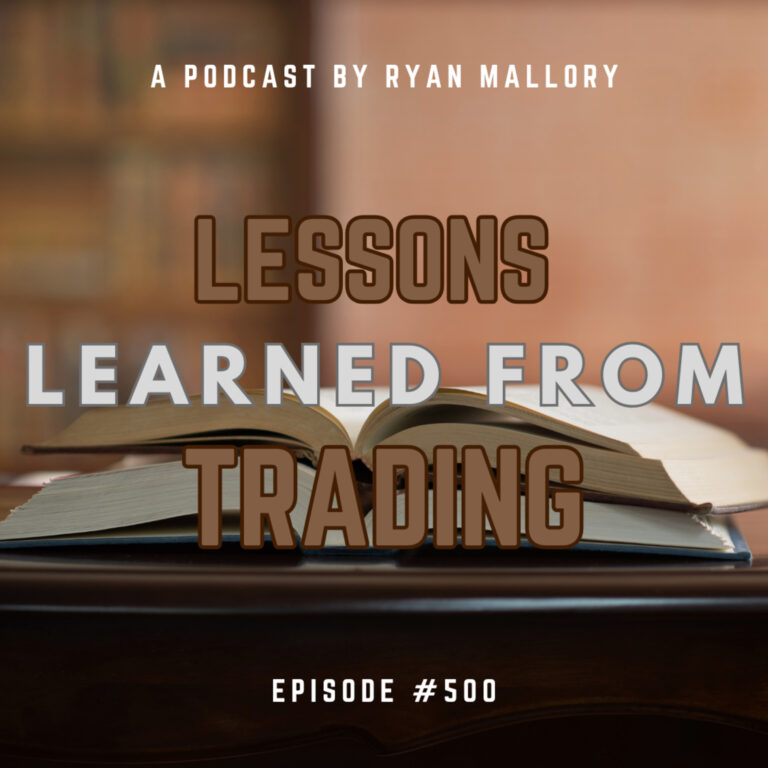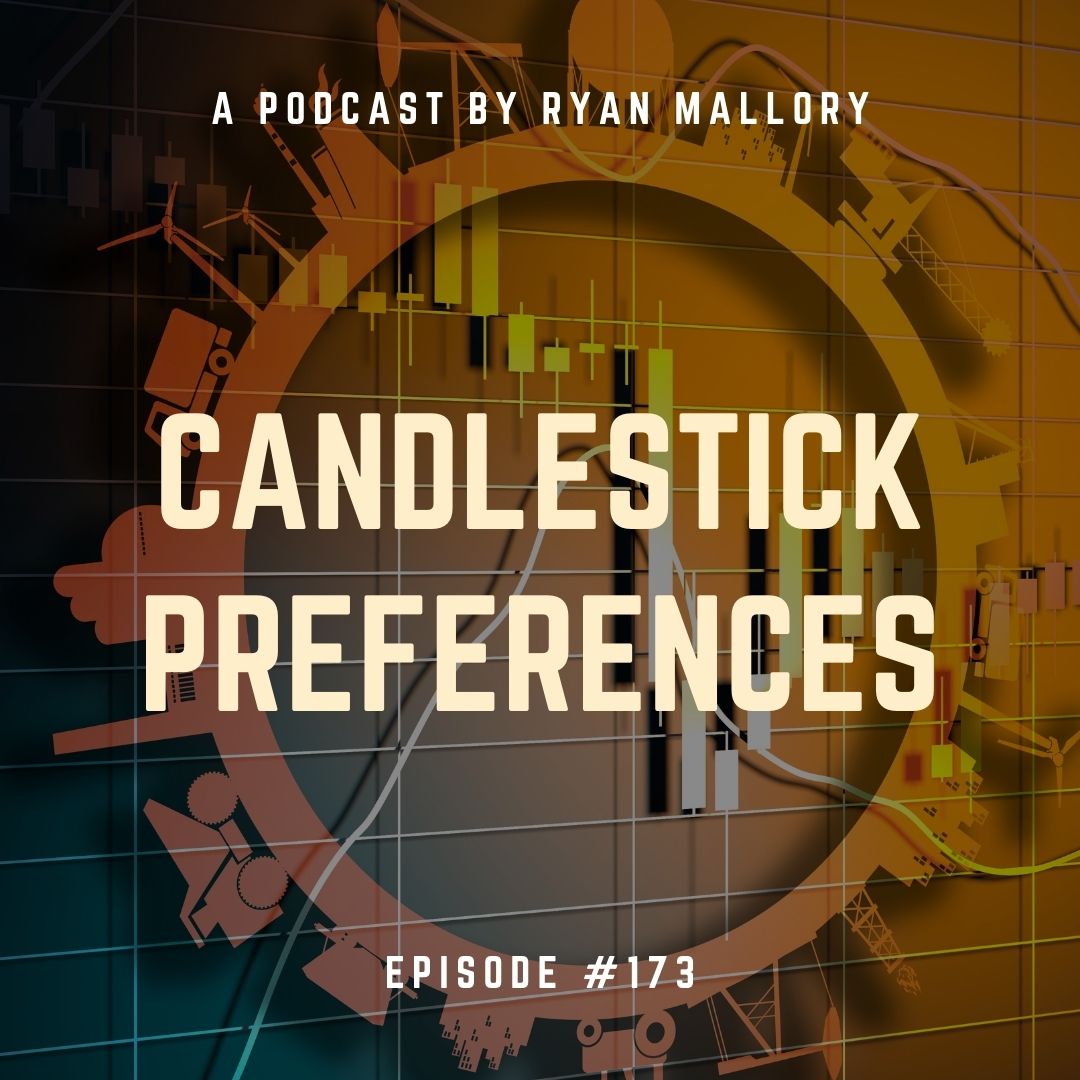Episode Overview
What parts of a candlestick are the best for you to use as a trader when it comes to drawing trend-lines, support and resistance. Ryan examines this question in full detail!
Available on: Apple Podcasts | Spotify | Amazon | YouTube
Episode Highlights & Timestamps
- [0:07] Why This Charting Topic Matters
Ryan opens the episode by introducing the question of whether to chart with candle wicks or candle bodies and explains why this decision can shape how traders view support, resistance, and patterns. - [1:31] Listener’s Dilemma
Bo Teef asks why Ryan uses the wicks for trendlines instead of just the open and close prices. - [4:31] Candlestick Basics
Ryan explains the anatomy of a candlestick and sets a foundation for understanding candle body vs. wick interpretation. - [5:30] The Importance of the Close
He emphasizes the value of the closing price and how it validates or negates a trendline break. - [7:33] No One Size Fits All
Each chart has a unique theme. Some validate trendlines with wicks, others with candle bodies, and many with a combination of both.
Key Takeaways from This Episode:
- Candlestick Context Matters: Don’t assume one part of the candlestick is always more important. Let the chart’s pattern tell the story.
- Closing Price Dominates: Among all candle elements, the closing price often carries the most technical weight.
- Wicks Reflect Price Extremes: Highs and lows (wicks) may reveal critical reactions or failed breakouts.
- Avoid Charting Dogma: Rigidly adhering only to body closes or only to wicks can blind you to valid patterns.
- Focus on the Pattern Theme: Use trendlines and support or resistance to amplify the dominant price behavior of the chart, whether it’s off wicks, closes, or both.
Resources & Links Mentioned:
- Swing Trading the Stock Market – Daily market analysis, trade setups, and insights by Ryan Mallory.
- Join the SharePlanner Trading Block – Get real-time trade alerts and community support.

Take the Next Step:
✅ Stay Connected: Subscribe to Ryan’s newsletter to get free access to Ryan’s Swing Trading Resource Library, along with receiving actionable swing trading strategies and risk management tips delivered straight to your inbox.
📈 Level Up Your Trading: Ready for structured training? Enroll in Ryan’s Swing Trading Mastery Course, The Self-Made Trader, and get the complete trading course, from the foundational elements of trading to advanced setups and profitable strategies.
📲 Join the Trading Community: Sign up for SharePlanner’s Trading Block to become part of Ryan’s swing-trading community, which includes all of Ryan’s real-time swing trades and live market analysis.
Full Episode Transcript
Click here to read the full transcript
0:07
Hey, I’m Ryan Mallory and this is my Swing Trading the Stock Market podcast. I’m here to teach you how to trade in a complex ever-changing, world of Finance, learn what it means to trade, profitably and consistently managing risk, avoiding the pitfalls of trading. And most importantly, to let those winners run wild, you can succeed at the stock market and I’m ready to show you how, hey, everybody, this is Ryan Mallory with Swing Trading the Stock Market and I got a good episode here about charting preferences, particularly about the candle bodies.
0:40
And why do I go off of the Wix or the Shadows versus using the opening and closing price it? So it’s a good question and I’m going to go ahead and jump into this email right now. He says hi Ryan by the way. We’re gonna call this guy Bo teef. Give him a good Florida redneck name.
0:57
He says, I intend this as a podcast question. Just not sure if they’ll get into the right folder. He says, anyways, my question is centered on charting preferences. I’ve been A few years but we consider myself a fair interpreter of the charts. Definitely nowhere near your level when it comes to the technicals.
1:13
I have observed your charts the past month, or so, after joining, SharePlanner. And I’m curious as to why you prefer using the candle wicks to indicate patterns instead of closing bodies. I have watched several videos throughout my trading career and have always sided with the guys who use the open and close instead of the extended highs and lows.
1:31
Just because logically it made sense to me that this would be a better indicator of Of price then plotting points at the extremes. I’m sure this isn’t a big deal at all. Just curious as to why you draw trend lines in this manner, I would really appreciate the information you provide in a has always helped me to become a better Trader, any additional information.
1:49
You could provide on a technical analysis, basis would be very much appreciated as I don’t recall running across an episode yet, where you really discuss charting these metrics and depth. Thank you again for being a reliable voice in this new. And what seems like a crazy age of Trading.
2:05
God bless Bo teef. All right, that’s a good question. And now, look, I don’t just go after questions that are going to be easy, softball questions to answer. This is a pretty hard question, especially the tackle on a podcast because it’s probably a little bit easier. If I have a chart that I can throw in front of you and explain it there.
2:24
But the whole purpose of this podcast is to make it to where you don’t need a chart in front of you, that you can be listening on a ride home from work or on your way to work or on your way back from what? Ever, it might be. I want this podcast to be easy for you to listen to. So that’s what we’re going to do now for the bourbon of choice for today.
2:43
It’s actually a little bit, something different. Was that the ABC store is trying to find something interesting to use for tonight’s episode. And I came up with this, it was like 10 bucks. I had to try it, it’s called Knob Creek the old-fashioned. So they actually come up with their own Nam Creek old-fashioned, not Creek, does, of course.
3:02
So I got it. I said, I’m going to try this out and see what it’s like. I’m trying it. It just all you have to do is put it on the Rocks. Now, I also expressed an orange peel over, put a cherry in there, try to make it as much. Like what I typically put in my old fashioned outside of what they say, they put in there. Like the simple syrup and the Bitters and the who’s, of course, I give it like a 48.
3:20
It just isn’t that good? It tastes very diluted. They tell you to put it on the Rocks, it’s very diluted. And with that dilution, it’s also a little bit too sweet. There’s just not enough bite to it. And it’s funny because when I make my own old Fashions, I use Knob Creek. Nine year.
3:36
So it just doesn’t give me that same month. So apparently there’s just a little bit of a difference there it may be that they’re using less of the bourbon and the drink and that’s a good possibility. I don’t know them. What I might use, I use two ounces. A lot of people only use one and a half ounces. I’m not sure what they’re doing here, but overall, I give it a 4 8.
3:54
I just can’t go any higher than that. If that’s all I had to choose from. I probably would just drink water to be honest. That’s all I would do. There’s just nothing there that really makes me want to get a glass out with an ice cube and Some of this old fashioned mixture over and I know this is becoming a popular thing.
4:09
I just don’t see it. Anyways, that’s the bourbon that I’m drinking here. It’s not that great, but and we’re going to knock out this question on the less. So he’s basically asking okay when you draw trend lines, when you’re drawing support and resistance levels, that requires that you connect different candle bodies for who, those who don’t know what a candle body is, or what a Candlestick on a chart is it’s this little rectangular Square.
4:31
Usually, they come in different shapes and sizes, sometimes it’s more like a square sometimes. It looks more like a dash the body. The the shape of it that indicates the opening and closing prices, then you have these little lines that will stick out of it. And again, those can vary from size depending on the market action overall, on the day.
4:48
For some of you guys who know what candlesticks are, this is kind of repetitive, I apologize but I just want to set the tone for those who are not as familiar with it. It only takes a second. Those long lines that come out of it. Those represent the highs and the lows of the day for the stock so I won’t get any further into that because It’s much more difficult to try to explain it without a chart, right in front of you.
5:09
So what he’s saying here is that most people that he has seen over the years have mainly, or primarily ignored the highs and the lows. I don’t necessarily think that’s a good approach because the highs and lows still represent the overall price action on today. Otherwise like things like do, jeez, you really wouldn’t be able to identify them if you’re only concerned with the opening and close.
5:30
Now, I do think the closing price is essential the most important part of a Candlestick. We’re in. Since you have this rising up Trend and it’s been in place for like a year or two years or however long okay, but just, it’s been in place for a while and every time it’s consistently bounced off of it and then you have this big sell-off that takes price intraday below that long-term trend line whether it’s a weekly chart, a yearly chart, a monthly or daily chart and it breaks below it.
5:54
But by the end of the day it has rallied back in closes back above that Rising trend line, that trend line still intact. Yes, there is an intraday blip but it had enough strength to recover. For the closed to close above that. So I will oftentimes ignore that lower Shadow and the same thing goes with a downtrend.
6:11
If a stock is breaking up and a through a declining trend line, but then, it fails and it head fakes and it comes right back down. Inside, that declining trend line will. The trend line is still intact because that closing price is that essential but there’s also going to be times too when you’re drawing this chart and you’re going to see where the trend line bounces, exactly the lows of that intraday price action bounces exactly off of that Rising.
6:35
Red line, and you have to consider that, you can’t just ignore that. And for those of you who are part of swingtradingthestockmarket.com, and that’s the website that goes along with this podcast, where you get all of my market information, that’s going to include weekly updates on the S&P 500.
6:51
And NASDAQ 100, the Russell 2000, plus weekly updates on all of the Fang, stocks plus Microsoft, Plus Tesla, and you’re going to get my weekly watch list with bullish and bearish and daily trade setups each and every day. Including My list of stocks that I’m looking at trading from check that out.
7:09
Swing trading the stock market. Now, each stock is going to be different, you can’t apply as like, okay only look at opening and closing prices for every single chart that you go through know. In some cases you’re going to have constant breaks below a trend line. And the only thing that’s going to be of importance, is that opening and closing price because that’s where their True trendline Lies, but every chart is going to be different.
7:33
You can’t look at every chart Exactly the same because a lot of times you’ll see this stock that continuously breaks below a key price support level. But by the clothes, it’s always back above it. Oh yeah, you can say, enter day, it broke below it, but it didn’t give you that confirmation, that you need to buy getting price to close below that key support level.
7:55
And so whether it’s a price support level or whether it’s a rising trend line or a declining trend line. The closing price is very important but there’s also going to be plenty of rising. Lines are the best defined by the fact that the lows of the Day held that trend line perfectly each and every time and while the opening and closing price might close above that Rising trend line that you’re looking at.
8:17
It doesn’t really interact with that Rising trend line. It might have Gap below with an opening price and then entered a sold off a little bit more by the close, the closing price was above the trend line, but the opening closing price isn’t necessarily closing on that trend line that you can draw a line through that area.
8:35
Area. Instead, you’re working off of the lows of the price action. Now, I know again, this is kind of getting a little bit into the difficulty of maybe picturing some of the stuff in your head but I’m not looking at a chart when I’m trying to explain this to you. So I’m trying to explain it to you as if you were sitting across from me at a coffee table and I didn’t have anything to write with or anything to draw on.
8:53
I’m just telling you exactly how it looks verbally. Now, another thing that I would tell you too, if somebody is just only looking at the opening and closing prices, there may be a personal strategy there that utilizes, just the opening and closing prices. For me, I don’t care as much about the opening prices, I just don’t, it’s because the opening price often takes place in one of the most undependable and volatile moments of the overall Market day.
9:16
And that’s the first 30 minutes of trading. In fact, when it comes to trading the first 30 minutes, I won’t do it, I will not do it. If I want to get into stock ABC at $100 and it goes up to 100 dollars in blows right through it in the first 30 minutes. I’m not taking that trade will not take it on that break out. Even if it goes to $110, I’m not going to chase it.
9:34
Instead, let’s say I want to Get into stock ABC at 100, and in that first 30 minutes, it goes up to 102 dollars. Well then I’ll wait to see if it starts to pull back some. And let’s say by the end of the 30 minute period, it starts to pull back and now it’s only at $101. Well, usually what I will do is make my entry price based off of a break at the high of the day.
9:52
That way, I know that price action is willing to go above and beyond what it’s already crossed on the day. So if that high of the day is 102, then I’ll probably put my entry price at 100 and 200 one because I want to Lead the break of the highs of the day because the 30 minutes is the least reliable time of the trading day, and you can’t put much emphasis on it.
10:14
That’s why I don’t put a big emphasis on the opening price because that’s not likely to hold. I mean, how many times have you seen a stopgap way down? And then by the end of the day it’s trading way, higher or even when the markets rally and you’ll have your stock for a moment gap down or just sell off a little bit in that first, couple of minutes of trading before, just takes off to the upside and vice versa.
10:34
You can have stock That opens higher and then it sells off the rest of the day. So I don’t put a lot of emphasis on that opening price. I actually think the high price, and the low price is more important than the opening price and that the closing price is more important than all of them combined when you take line charts and I don’t use line chart.
10:50
Some people will look at them, they’re all based off of the closing price. Why? Because the closing price, on whatever time frame you’re looking at is the most important price on the chart, but to Bow Chiefs question. It’s not so much that I For the highs and the lows to the opening and closing price.
11:08
Instead, I really am trying to find the theme of every chart that I look at. And sometimes the theme of a chart is that the technicals are lining up with the low Wicks of a candle that lower shadow of a Candlestick. And when that happens on going to respect that when I see a rising trend line in that trend lines, consistently being tested by the lows of the day.
11:28
There’s your pattern right there. Technical analysis is there to help you to find patterns whether that’s using the opening price. The closing price the lows of the day or the highs of the day, you’re looking for the patterns. A lot of people put emphasis for instance on moving averages and it’ll say hey it couldn’t hold the 50-day moving average will who cares if there’s not a history or a pattern of the stock actually holding the 50-day moving average because it’s not significant unless it’s held the 50-day moving average in the past if it blows through it on a regular basis who cares if it couldn’t hold the 50-day moving average, it’s never shown any respect to the 50-day moving average.
12:00
So, when it comes to charting, when you’re doing technical analysis on these different stocks, You’re looking really for the patterns and these lines in these drawings that you put on the charts are really helping you highlight what the patterns are. So it’s not so much that I favor, the lows are the highs of the day over the opening closed as more so that when the lows and the highs of the day develop a pattern worth noting.
12:24
Yes I will favor those over the opening and closing prices and sometimes here’s the other kicker. There’s plenty of times where I will acknowledge both of them in different capacities because the Turns not so much following the opening price or the closing prices only or the upper shatter and the lower Shadow only, but instead it’s doing a combination of those.
12:44
So you have this trend line where you have on some retests price, goes below the trend line and comes right back up and holds it into the clothes and on other retest, its touching it perfectly at the lows of the day and then bouncing. And so you can have a combination and your patterns that you’re following of we’re on this retest.
13:03
It was the opening price that matter in This retest, it was the closing price that mattered in on this test. It was the lows on that shadow that mattered and so really you can get a myriad of different combinations. And so what a lot of this comes down to is you using the candlesticks as a tool to find the patterns on the overall stock.
13:23
So I hope I didn’t make it too complex for you because I know that charting is a very visual thing and so trying to take something that’s very Visual and make it for you in a podcast. That you’re only able to listen to can be somewhat of a challenge. That’s why you see a lot of times, I’m focusing on the psychological aspects of trading and not so much.
13:42
The technical analysis in the real nitty-gritty stuff of what technical analysis actually is, but I felt like I could tackle this particular question for this podcast and I hope I did a good job of that. If you have any questions, feel free to email me ryan@shareplanner.com.
13:58
I still love taking your questions for this podcast. It’s developed over the years and to make a Centric podcast where I’m taking your questions and I’m answering them. And the only way I can do that is I keep getting your emails so keep sending them to me. Also, make sure to check me out in the Apple app and Spotify and everywhere else and make sure to leave some five-star reviews.
14:20
And if this podcast has been helpful at all, please let me know. I read every one of those reviews and they do mean the world to me. So please make sure to put those reviews out there. They mean so much to me. Thank you guys. God bless. Thanks for listening to my podcast. Swing trading the stock market.
14:37
I like to encourage you to join me in the SharePlanner Trading Block, where I navigate the stock market, each day with Traders from around the world with your membership, you will get a 7 day trial and access to my trading room including alerts via text email and WhatsApp. So go ahead, sign up by going to shareplanner.com trading block, that’s www.shareplanner.com/trading-block.
14:59
And follow me on SharePlanner’s, Twitter, Instagram, and Facebook. Facebook where I provide unique market and trading information every day you have any questions please feel free to email me at ryan@shareplanner.com all the best to you and I look forward to trading with you soon.
Enjoy this episode? Please leave a 5-star review and share your feedback! It helps others find the podcast and enables Ryan to produce more content that benefits the trading community.
Have a question or story to share? Email Ryan and your experience could be featured in an upcoming episode!
Become part of the Trading Block and get my trades, and learn how I manage them for consistent profits. With your subscription you will get my real-time trade setups via Discord and email, as well as become part of an incredibly helpful and knowledgeable community of traders to grow and learn with. If you’re not sure it is for you, don’t worry, because you get a Free 7-Day Trial. So Sign Up Today!

Welcome to Swing Trading the Stock Market Podcast!
I want you to become a better trader, and you know what? You absolutely can!
Commit these three rules to memory and to your trading:
#1: Manage the RISK ALWAYS!
#2: Keep the Losses Small
#3: Do #1 & #2 and the profits will take care of themselves.
That’s right, successful swing-trading is about managing the risk, and with Swing Trading the Stock Market podcast, I encourage you to email me (ryan@shareplanner.com) your questions, and there’s a good chance I’ll make a future podcast out of your stock market related question.
In today's episode, at episode 500, I am diving into the lessons learned from trading over the last 100 episodes, because as traders we are evolving and always attempting to improve our skillset. So here is to episode 500, and to another 500 episodes of learning and developing as swing traders in the stock market!
Be sure to check out my Swing-Trading offering through SharePlanner that goes hand-in-hand with my podcast, offering all of the research, charts and technical analysis on the stock market and individual stocks, not to mention my personal watch-lists, reviews and regular updates on the most popular stocks, including the all-important big tech stocks. Check it out now at: https://www.shareplanner.com/premium-plans
📈 START SWING-TRADING WITH ME! 📈
Click here to subscribe: https://shareplanner.com/tradingblock
— — — — — — — — —
💻 STOCK MARKET TRAINING COURSES 💻
Click here for all of my training courses: https://www.shareplanner.com/trading-academy
– The A-Z of the Self-Made Trader –https://www.shareplanner.com/the-a-z-of-the-self-made-trader
– The Winning Watch-List — https://www.shareplanner.com/winning-watchlist
– Patterns to Profits — https://www.shareplanner.com/patterns-to-profits
– Get 1-on-1 Coaching — https://www.shareplanner.com/coaching
— — — — — — — — —
❤️ SUBSCRIBE TO MY YOUTUBE CHANNEL 📺
Click here to subscribe: https://www.youtube.com/shareplanner?sub_confirmation=1
🎧 LISTEN TO MY PODCAST 🎵
Click here to listen to my podcast: https://open.spotify.com/show/5Nn7MhTB9HJSyQ0C6bMKXI
— — — — — — — — —
💰 FREE RESOURCES 💰
— — — — — — — — —
🛠 TOOLS OF THE TRADE 🛠
Software I use (TC2000): https://bit.ly/2HBdnBm
— — — — — — — — —
📱 FOLLOW SHAREPLANNER ON SOCIAL MEDIA 📱
*Disclaimer: Ryan Mallory is not a financial adviser and this podcast is for entertainment purposes only. Consult your financial adviser before making any decisions.





